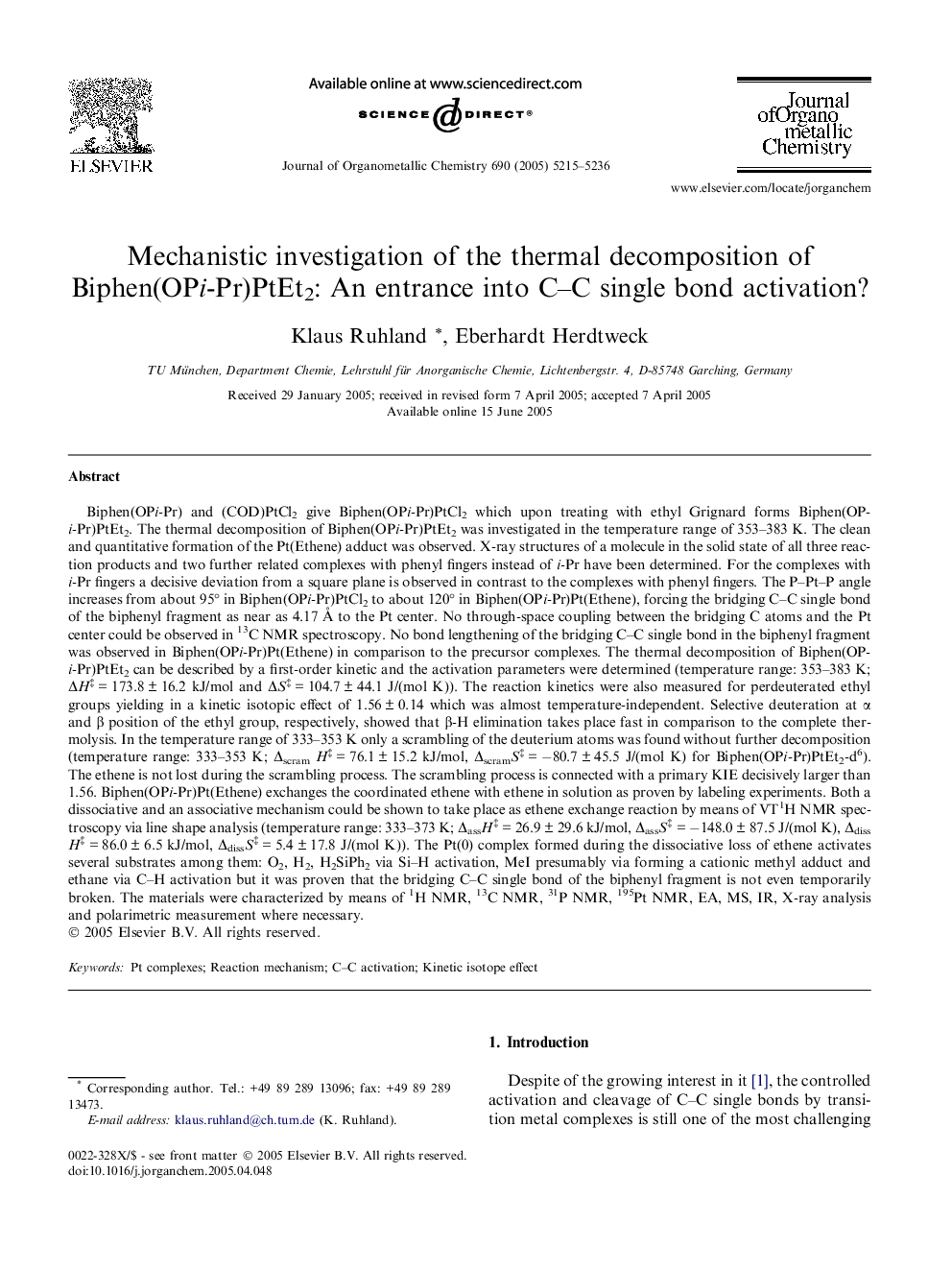| کد مقاله | کد نشریه | سال انتشار | مقاله انگلیسی | نسخه تمام متن |
|---|---|---|---|---|
| 1327242 | 977470 | 2005 | 22 صفحه PDF | دانلود رایگان |

Biphen(OPi-Pr) and (COD)PtCl2 give Biphen(OPi-Pr)PtCl2 which upon treating with ethyl Grignard forms Biphen(OPi-Pr)PtEt2. The thermal decomposition of Biphen(OPi-Pr)PtEt2 was investigated in the temperature range of 353–383 K. The clean and quantitative formation of the Pt(Ethene) adduct was observed. X-ray structures of a molecule in the solid state of all three reaction products and two further related complexes with phenyl fingers instead of i-Pr have been determined. For the complexes with i-Pr fingers a decisive deviation from a square plane is observed in contrast to the complexes with phenyl fingers. The P–Pt–P angle increases from about 95° in Biphen(OPi-Pr)PtCl2 to about 120° in Biphen(OPi-Pr)Pt(Ethene), forcing the bridging C–C single bond of the biphenyl fragment as near as 4.17 Å to the Pt center. No through-space coupling between the bridging C atoms and the Pt center could be observed in 13C NMR spectroscopy. No bond lengthening of the bridging C–C single bond in the biphenyl fragment was observed in Biphen(OPi-Pr)Pt(Ethene) in comparison to the precursor complexes. The thermal decomposition of Biphen(OPi-Pr)PtEt2 can be described by a first-order kinetic and the activation parameters were determined (temperature range: 353–383 K; ΔH‡ = 173.8 ± 16.2 kJ/mol and ΔS‡ = 104.7 ± 44.1 J/(mol K)). The reaction kinetics were also measured for perdeuterated ethyl groups yielding in a kinetic isotopic effect of 1.56 ± 0.14 which was almost temperature-independent. Selective deuteration at α and β position of the ethyl group, respectively, showed that β-H elimination takes place fast in comparison to the complete thermolysis. In the temperature range of 333–353 K only a scrambling of the deuterium atoms was found without further decomposition (temperature range: 333–353 K; ΔscramH‡ = 76.1 ± 15.2 kJ/mol, ΔscramS‡ = −80.7 ± 45.5 J/(mol K) for Biphen(OPi-Pr)PtEt2-d6). The ethene is not lost during the scrambling process. The scrambling process is connected with a primary KIE decisively larger than 1.56. Biphen(OPi-Pr)Pt(Ethene) exchanges the coordinated ethene with ethene in solution as proven by labeling experiments. Both a dissociative and an associative mechanism could be shown to take place as ethene exchange reaction by means of VT1H NMR spectroscopy via line shape analysis (temperature range: 333–373 K; ΔassH‡ = 26.9 ± 29.6 kJ/mol, ΔassS‡ = −148.0 ± 87.5 J/(mol K), ΔdissH‡ = 86.0 ± 6.5 kJ/mol, ΔdissS‡ = 5.4 ± 17.8 J/(mol K)). The Pt(0) complex formed during the dissociative loss of ethene activates several substrates among them: O2, H2, H2SiPh2 via Si–H activation, MeI presumably via forming a cationic methyl adduct and ethane via C–H activation but it was proven that the bridging C–C single bond of the biphenyl fragment is not even temporarily broken. The materials were characterized by means of 1H NMR, 13C NMR, 31P NMR, 195Pt NMR, EA, MS, IR, X-ray analysis and polarimetric measurement where necessary.
The [1]Pt(Ethene) complex illustrated was synthesized via thermolysis of the [1]PtEt2. Mechanistic investigations show that the ethene in [1]Pt(Ethene) is temporarily dissociated. We investigated whether by dissociation of the ethene the bridging C–C single bond of the biphenyl fragment can be activated.Figure optionsDownload as PowerPoint slide
Journal: Journal of Organometallic Chemistry - Volume 690, Issue 23, 15 November 2005, Pages 5215–5236